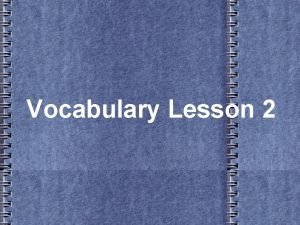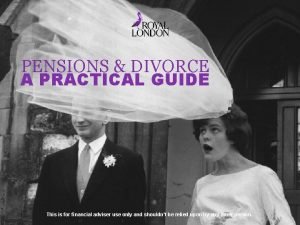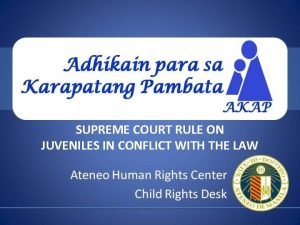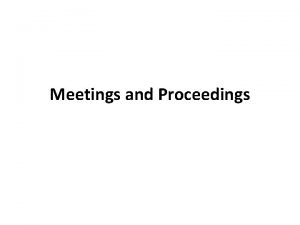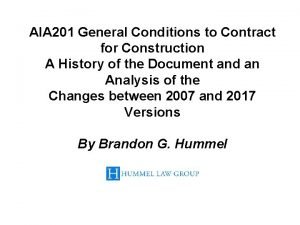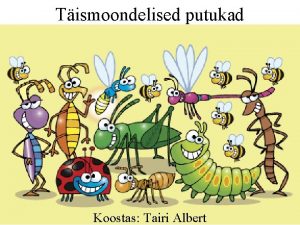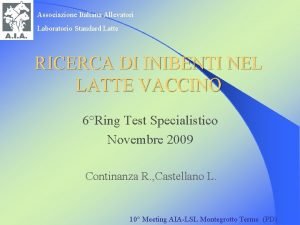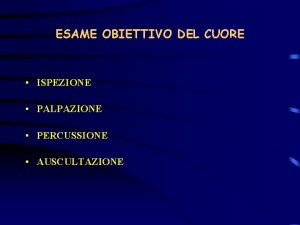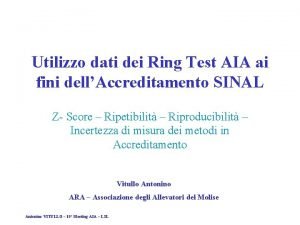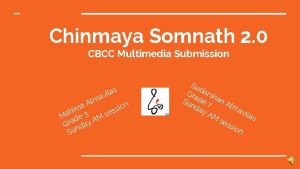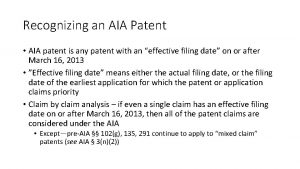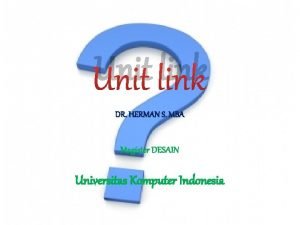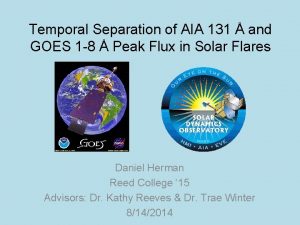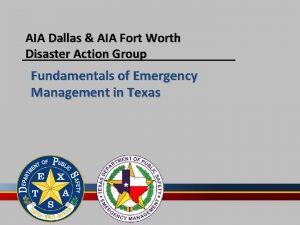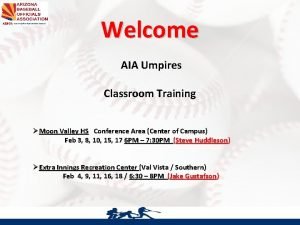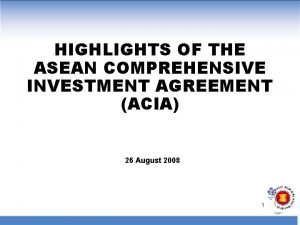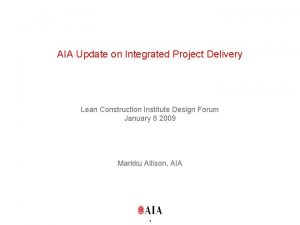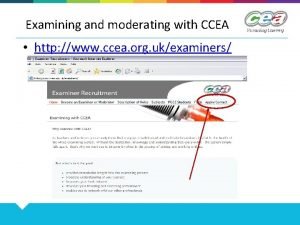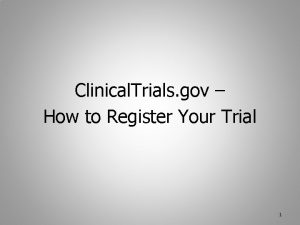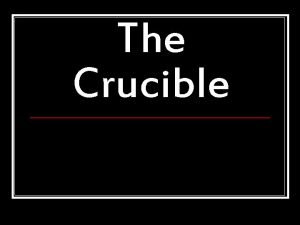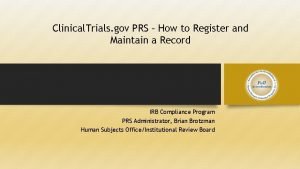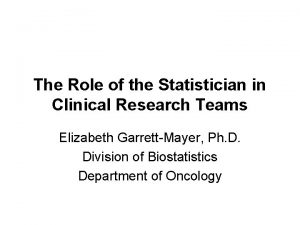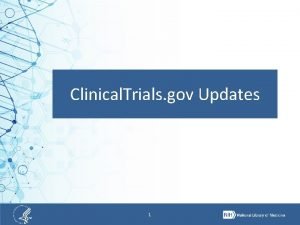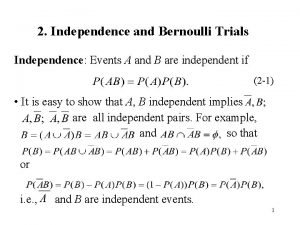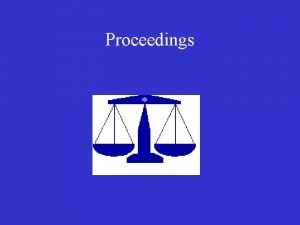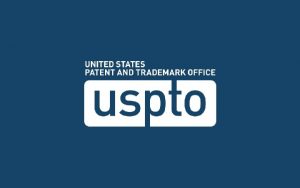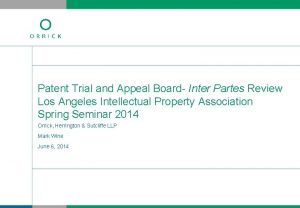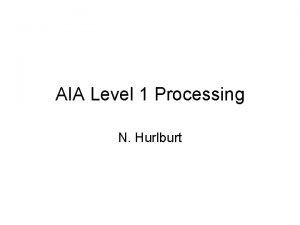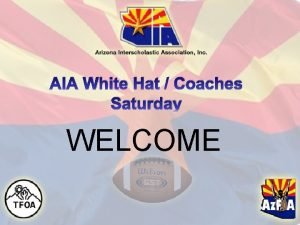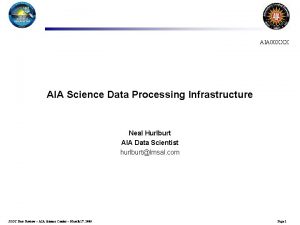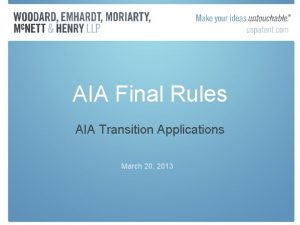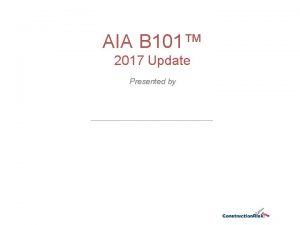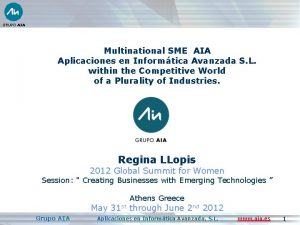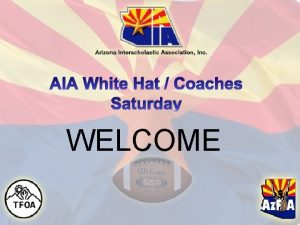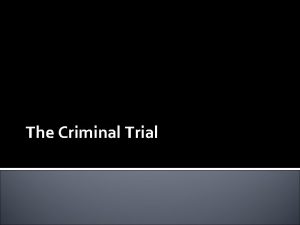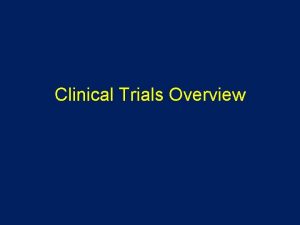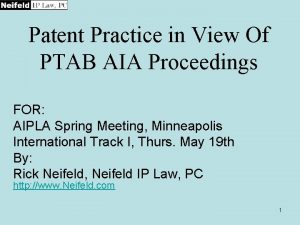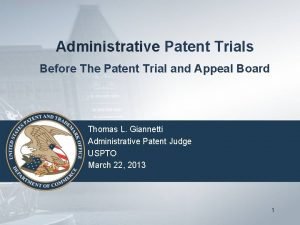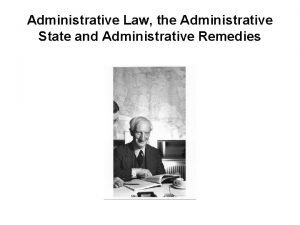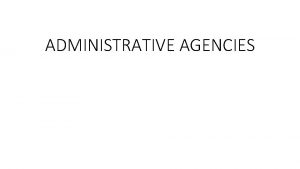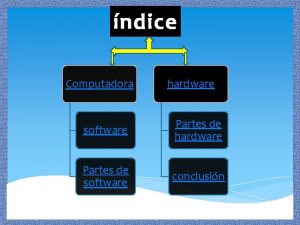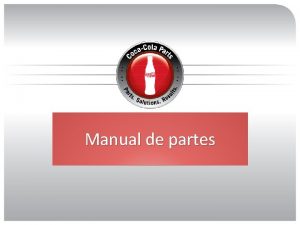Administrative Trials 1 AIA Trial Proceedings Inter Partes



























- Slides: 27

Administrative Trials 1

AIA Trial Proceedings Inter Partes Review §§ 42. 100 – 42. 123 Post-Grant Review §§ 42. 200 – 42. 224 Umbrella Trial Rules §§ 42. 1 – 42. 80 Covered Business Method Patent Review §§ 42. 300 – 42. 304 Derivation Proceeding §§ 42. 400 – 42. 412 2

AIA Trial Proceedings Representative timeline: Petition 3 PO Prelim. Respon se PO Respon se/ Motion to Amend Decisio n/ Institutio n <3 3 Trial Begins Petition er Reply/ Opposit. 3 Oral Hearin g PO Reply 1 2 Final Written Decisio n < 3 months < One Year 3

Major Differences between IPR, PGR, and CBM IPR All patents are eligible. Petitioner has not filed an invalidity action and petition is filed no more than one year after service of infringement complaint for the patent. Only §§ 102 and 103 grounds based on patents or printed publication are permitted. PGR Only FITF patents are eligible. Petitioner has not filed an invalidity action. Only §§ 101, 102, 103, and 112, except best mode, grounds are permitted. CBM Both FTI & FITF patents are eligible, but must be a covered business method patent. Petitioner must be sued or charged w/ infringement. Only §§ 101, 102, 103, and 112, except best mode, grounds are permitted. 4

Threshold Standards for Institution IPR Petition must demonstrate a reasonable likelihood that petitioner would prevail as to at least one of the claims challenged. PGR/CBM Petition must demonstrate that it is more likely than not that at least one of the claims challenged is unpatentable. PGR/CBM: Greater than 50% chance IPR: May encompass a 50/50 chance 5

Administrative Patent Trials • In general, a person who is not the patent owner may file an IPR/PGR/CBM petition in the following time periods: IPR First-to-Invent CBM Patents After issuance > 9 months from issue date First-Inventorto-File PGR IPR or CBM < 9 months from issue date > 9 months from issue date Patents 6

Inter Partes Review • All patents are eligible for an IPR. § 6(c)(2)(A) of AIA. • A person who is not the patent owner and has not previously filed a civil action challenging the validity of a claim of the patent may file an IPR. 35 U. S. C. 315(a)(1); § 42. 101. • An IPR petitioner may request to cancel, as unpatentable, one or more claims of a patent only on a ground that could be raised under § 102 or 103 and only on the basis of prior art consisting of patents or printed publications. 35 U. S. C. 311(b); § 42. 104(b)(2). • An IPR petition cannot be filed until after the later of: 1) 9 months after the grant of a patent or issuance of a reissue of a patent; or 2) the date of termination of any post grant review of the patent. 35 U. S. C. 311(c); § 42. 102(a). 7

Inter Partes Review • Petition must: – Be accompanied by a fee. 35 U. S. C. 312(a)(1); § 42. 15 & 42. 103. – Identify all real parties in interest. 35 U. S. C. 312(a)(2); § 42. 8. – Identify all claims challenged and grounds on which the challenge to each claim is based. 35 U. S. C. 312(a)(3); § 42. 104(b). – Provide a claim construction and show the construed claim is unpatentable based on the grounds alleged. § 42. 104(b). – Provide copies of evidence relied upon. 35 U. S. C. 312(a)(5); § 42. 6(c). – Certify that the petitioner is not estopped from proceeding. § 42. 104(a). 8

Inter Partes Review Patent owner preliminary response • A patent owner may file a preliminary response to the petition to provide reasons why no IPR should be instituted. 35 U. S. C. 313; § 42. 107(a). • Preliminary response is due 3 months from petition docketing date. § 42. 107(b). • Patent owners may provide testimonial evidence in a preliminary response where interests of justice so require, e. g. , to demonstrate that petitioner’s real party in interest is estopped from challenging patent claims. See Practice Guide, Section II. C. 9

Inter Partes Review Threshold and Institution • An IPR petition must demonstrate a reasonable likelihood that petitioner would prevail as to at least one of the claims challenged. 35 U. S. C. 314(a); § 42. 108(c). • Where IPR standards are met, the Board will institute the trial on: 1) claim-by-claim basis; and 2) ground-by-ground basis. § 42. 108(a) & (b). – A party may request that panel rehears decision on petition. § 42. 71(c) & (d). • An IPR trial will be completed within one year from institution, except the time may be extended up to six months for good cause. 35 U. S. C. 316(a)(11); § 42. 100(c). 10

Inter Partes Review Patent owner response (35 U. S. C. 316(a)(8); § 42. 120) • A patent owner may file a response to petition addressing any ground for unpatentability not already denied by the Board. • In submitting a response, the patent owner must file, through affidavits or declarations, any additional factual evidence and expert opinions on which the patent owner relies in support of the response. • The default date for filing a patent owner response is 3 months from institution. 11

Inter Partes Review Motion to Amend (35 U. S. C. 316(a)(9), (b) & (d); § 42. 121) • Authorization is not required to file the initial motion to amend, but conferring with the Board is required. • The motion to amend may cancel any challenged claim and/or propose a reasonable number of substitute claims. • Additional motion to amend may be authorized for good cause, e. g. , where supplemental information is belatedly submitted. • Motions to amend may be limited to prevent abuse and to aid in efficient administration and timely completion of the proceeding. 12

Post-Grant Review • Most aspects of PGR and IPR are effectively the same. • There are some differences between a PGR and an IPR, such as: – With limited exceptions, only those patents issuing from applications subject to first-inventor-to-file provisions are eligible. § 6(f) of AIA. – PGR allows challenges based on §§ 101, 102, 103, and 112, except best mode. 35 U. S. C. 321(b); § 42. 204(b)(2). – PGR may only be requested on or prior to the date that is 9 months after the grant of a patent or issuance of a reissue patent. 35 U. S. C. 321(c); § 42. 202(a). – Petition must demonstrate that it is more likely than not (i. e. , a higher threshold than IPR) that at least one of the claims challenged in the petition is unpatentable. 35 U. S. C. 324(a); § 42. 208(c). 13

Covered Business Methods • CBM proceedings employ the PGR standards and procedures subject to certain exceptions. § 18(a)(1) of AIA; § 42. 303(a). • Differences between a CBM and a PGR include: – Cannot file CBM petition during time a PGR petition could be filed, i. e. , 9 months after issuance of a patent. § 18(a)(2) of AIA. – Petitioner must be sued or charged with infringement. § 18(a)(1)(B) of AIA; § 42. 302(a). – Petitioner has burden of establishing that patent is eligible for CBM review. § 42. 304(a). – Prior Art is limited when challenging a first-to-invent patent. § 18(a)(1)(C) of AIA. 14

Covered Business Methods Eligible patents: • Both first-to-invent and first-inventor-to-file patents are eligible. §§ 6(f)(2)(A) & 18(a)(1) of AIA. • Must be a covered business method patent. § 18(d)(1) of AIA; § 42. 301. – Covered business method patent generally defined in the AIA as a method or corresponding apparatus for performing data processing or other operations for financial product or service. – The definition excludes patents for technological inventions. 15

Umbrella Rules • Per statutory requirements, real parties in interest will have to be identified. See, e. g. , 35 U. S. C. 312(a)(2), 322(a)(2); § 42. 8(b)(1). • Practice Guide (Section I. D) provides factors that may be considered in determining whether a party constitutes a real party in interest or privy. • Additionally, both petitioner and patent owner will be required to provide a certain level of information necessary to conduct the proceeding including related proceedings, lead and backup counsel, and contact information (email addresses and phone numbers). § 42. 8(b). 16

Umbrella Rules Practice Before the Board in the Trial Proceedings • The lead counsel must be a registered practitioner. • The Board may recognize counsel pro hac vice during a proceeding upon a showing of good cause, subject to the Office’s Code of Professional Responsibility and any other conditions as the Board may impose. § 42. 10(c). – E. g. , counsel is an experienced litigation attorney and has a familiarity with subject matter at issue. • Similarly, the Board may take action to revoke pro hac vice status, taking into account various factors, including incompetence, unwillingness to abide by the Office’s Code of Professional Responsibility, and incivility. § 42. 10. 17

Umbrella Rules Petition Fees (§ 42. 15) • Proposed fee escalation in block increments of 10 claims has not been adopted in the final rule. • Rather, the final rule establishes a flat fee for each additional challenged claim after 20. IPR PGR/CBM $ 27, 200 $ 35, 800 $ 600 for each additional claim > 20. $ 800 for each additional Derivation $ 400 claim > 20. 18

Umbrella Rules • Proposed page limits have been increased by 10 pages. The final rule provides the following (§ 42. 24): IPR PGR/CBM Derivation 60 pages 80 pages 60 pages For a petition, preliminary response, and PO response For a petition and opposition to petition • For claim charts, single spacing is permitted. § 42. 6(a)(2)(iii). • Statement of material facts in a petition or motion is optional. § 42. 22(c). 19

Umbrella Rules Testimony and document production is permitted • AIA authorizes the Office to set standards and procedures for the taking of discovery. 35 U. S. C. 316(a)(5) & 326(a)(5). • Discovery rules allow parties to agree to discovery between themselves. § 42. 51(a)(1) & (b)(2). • The final rules provide for mandatory initial disclosures, routine discovery, and additional discovery. § 42. 51. 20

Umbrella Rules • Routine discovery – reduces costs to parties by making basic information readily available at the outset of the proceeding. Routine discovery may assist the parties to assess the merits of their respective positions, to avoid harassment in the proceeding, or to reach settlement. § 42. 51(b)(1). – Routine discovery includes documents cited, crossexamination for submitted testimony, and information inconsistent with positions advanced during the proceeding. – Proposed rule on inconsistent statements has been modified to limit both scope and number of individuals subject to the rule. § 42. 51(b)(1)(iii). 21

Umbrella Rules Additional discovery • The parties may agree to additional discovery between themselves. Otherwise, a party must request any discovery beyond routine discovery. • A party seeking additional discovery in IPR and derivation must demonstrate that the additional discovery is in the interests of justice. 35 U. S. C. 316(a)(5) for IPR; § 42. 51(c). • A party seeking additional discovery in PGR and CBM will be subject to the lower good cause standard. 35 U. S. C. 326(a)(5) for PGR; § 42. 224. 22

Umbrella Rules Supplemental information (35 U. S. C. 316(a)(3); § 42. 123) • A request for the authorization to file a motion to submit supplemental information must be made within one month after institution. • The supplemental information must be relevant to a claim for which the trial has been instituted. • Any supplemental information filed later than one month after institution must show why the supplemental information reasonably could not have been obtained earlier and that consideration of the information would be in the interests-of-justice. 23

Umbrella Rules Petitioner Estoppels After Final Written Decision • A petitioner in an IPR/PGR/CBM may not request or maintain a proceeding before the Office with respect to any claim on any ground raised or reasonably could have been raised. 35 U. S. C. 315(e)(1), 325(e)(1); § 42. 73(d)(1). • A petitioner in an IPR/PGR/CBM may not assert in district court or the ITC that a claim is invalid on any ground petitioner raised, and in IPR/PGR, any ground that reasonably could have been raised. 35 U. S. C. 315(e)(2), 325(e)(2); § 18(a)(1)(D) of AIA. 24

Umbrella Rules Patent Owner Estoppel (§ 42. 73(d)(3)) • A patent owner is precluded from taking action inconsistent with the adverse judgment including obtaining in any patent: – A claim that is patentably indistinct from a finally refused or canceled claim. – An amendment of a specification or drawing that was denied during the trial, but this provision does not apply to an application or patent that has a different written description. • The proposed estoppel provision as to claims that could have been presented was not adopted in the final rule. 25

Questions? 26

Thank You Janet Gongola Sally Medley Patent Reform Coordinator Administrative Patent Judge Janet. Gongola@uspto. gov Sally. Medley@uspto. gov
 To stop proceedings temporarily; move to another place
To stop proceedings temporarily; move to another place Divorce process in india
Divorce process in india Flow chart of court proceedings in the philippines
Flow chart of court proceedings in the philippines Meeting adjournment
Meeting adjournment Aia201
Aia201 Klaastiib
Klaastiib Laboratorio standard latte
Laboratorio standard latte Ispezione palpazione percussione auscultazione
Ispezione palpazione percussione auscultazione Lsl aia
Lsl aia Aia ilas
Aia ilas Aia
Aia Aia 360 test menu
Aia 360 test menu Patent effective filing date
Patent effective filing date Nilai unit equity fund aia
Nilai unit equity fund aia Aia 131
Aia 131 Aia fort worth
Aia fort worth Settore tecnico aia
Settore tecnico aia Aia baseball rules
Aia baseball rules Acia
Acia Aia integrated project delivery
Aia integrated project delivery Ccea
Ccea Clinical trials.gov login
Clinical trials.gov login Site initiation visit in clinical trials ppt
Site initiation visit in clinical trials ppt How is the crucible unlike the salem witch trials?
How is the crucible unlike the salem witch trials? Prs register
Prs register Clinical research statistician
Clinical research statistician Clinical trials api
Clinical trials api Repeated bernoulli trials
Repeated bernoulli trials
